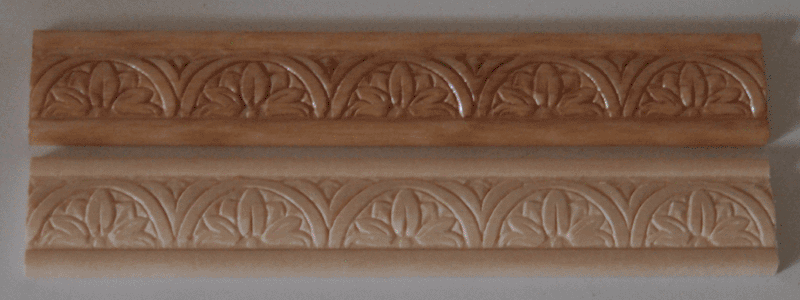
My previous varnish, while perfectly suitable for most interior applications, degrades quickly outdoors. When exposed to the weather, even with a coat of paste wax, the varnish will begin to show wear in about four months, and will have substantially failed within a year. As this is likely due to the inherent water absorption of linseed oil, I decided to make an improved varnish using tung oil, which is known to be essentially waterproof.
Due to its unique fatty acid profile, tung oil (from the seeds of the tung tree) dries faster and harder than any other natural oil in common use. Unfortunately, this is due to its rapid oxygen absorption, which greatly expands the volume of the oil and leads to significant wrinkling of the oil film. Worse still, attempting to pre-polymerize the oil by heating (boiling) it beforehand causes it to solidify instantaneously instead of thickening gradually. However, in a fortunate natural coincidence, this problem can be solved by the addition of pine rosin. When dissolved into tung oil during the heating process, rosin prevents the solidification of the oil, which itself then confers hardness and water resistance to the rosin in the final varnish film; the two make a perfect pair. To make such a varnish, I began with the following ingredients:
Preparing the varnish was as straightforward as possible; to start, the three ingredients were added to my large pyrex dish (the ferric acetate being ground into the oil, as usual), and heated to 220°C while stirring. I then took a sample every half hour by placing a drop onto cold glass, spreading it by hand, and placing it in the sun to dry. After three hours of heating, the drops had become nearly solid upon cooling, and the dried samples were only wrinkled in the thickest areas. I then removed the varnish from the heat, and once it had cooled to 100°C I added 100g of turpentine as a thinner, then filtered the warm varnish into a jar for storage. These steps can all be seen below.
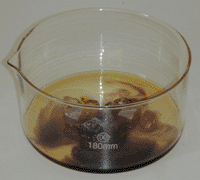
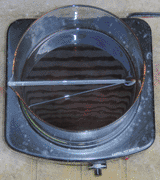
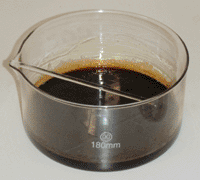
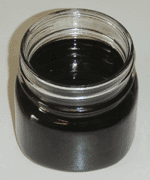
The resulting varnish is slightly thicker than my original rosin varnish, but is also somewhat slippery, so both are equally brushable. Furthermore, the amount of iron drying catalyst is the same, so both varnishes also have the same amber tint, which can be seen at the top of the page. This is where the similarities end, however. The tung oil varnish dries extremely quickly, becoming rubber-hard overnight indoors, and within an hour under direct sunlight. Full curing is likewise accelerated, with thin layers taking less than three days to reach final hardness. This hardness is greatly improved as well, and is similar to that of my asphaltum enamel. The varnish is also absolutely waterproof, and a sample dried on glass showed no change after being submerged in water for a day. The characteristic friction of the rosin is eliminated as well, and cured varnish films are slick to the touch. Finally, the one-step preparation allows for the rapid production of significant quantities of varnish, as needed for large projects.
Overall, this varnish appears to be superior in every way to its linseed oil equivalent, but weathering tests will have to be conducted to confirm this, and to identify any potential faults. Primarily, my concerns are that the impermeability of the varnish may trap moisture in the wood, and that its relative hardness may cause it to crack as the wood expands and contracts. These were areas where the linseed oil varnish actually performed well due to its permeability and softness, with its failure being due to gradual wear rather than catastrophic peeling. As tests and projects using this new varnish begin to age, it will be interesting to see how it degrades, and what its failure mode eventually will be.
While this varnish performs adequately when brushed on, I have found that it produces much nicer results when applied with a rag, much like linseed oil. If wiped on thinly it dries in four hours, and three coats will produce a finish similar to french polished shellac (but of course, totally waterproof). Due to the rapid drying time and ease of application, this is now my go-to method for finishing wood.
EDIT: 6/15/2020Although the color of this varnish can be varied by changing the proportion of ferric acetate used, this comes at the expense of undesirable drying characteristics. A better option that I've found is to tint the varnish with oil paint. If a transparent pigment (having a very fine particle size) is used in small quantities, the color can be shifted somewhat within the region of warm and neutral tones, without the varnish losing its transparency and obscuring the grain of the wood. One historical pigment commonly used for this purpose is madder lake, but a more lightfast option is to use transparent iron oxides, which I've found produce excellent results.
EDIT: 1/19/2025After several long-term durability tests, it appears that this varnish degrades in a very similar manner to my original linseed oil varnish when exposed to the weather. This is likely due to the effect of ultraviolet light on the rosin component, as the same varnish used indoors (and cleaned regularly with glass cleaner) shows no deterioration whatsoever. This behavior is similar to that of commercial polyurethane-based varnishes, and in general, glossy finishes tend to fail (or at least become flat) when kept outdoors. Specifically, penetrating oil finishes appear to be superior to thick varnishes for outdoor use, and I plan to adopt this as a design rule for future projects.
EDIT: 4/22/2025The above varnish can be greatly improved by a relatively unintuitive modification of both the oil and rosin. If a slurry is made from water, glycerine, and calcium hydroxide (each at 5% of the weight of the rosin) and added slowly (due to the frothing produced) to the hot varnish as soon as the iron catalyst is fully dissolved, the properties of the varnish significantly change. The molten mixture immediately becomes more viscous, yet no longer has any tendency to form a skin. The heating time is reduced to little over an hour, and after cooling below 150°C and thinning with turpentine as usual, the resulting varnish (when used at room temperature) dries to the touch within an hour or two, and is fully cured in four hours.
This is not simply due to a reaction between the lime, glycerine, and the acidic rosin; prepared separately, such a neutralized rosin produces a relatively poor varnish, even with tung oil. Instead, the product of this reaction is a complex mixture of calcium soaps and glycerides of both resinous and fatty acids. Originally developed in the 1920s, this was known as "tunga resin" and is likely the pinnacle of varnishes made from natural materials. The calcium content significantly raises the melting point of the varnish, while also acting as an auxiliary drying catalyst to the extent that ferric acetate is no longer strictly needed. Interestingly, the non-skinning property of the molten varnish also allows for an even greater amount of catalyst to be incorporated, if desired. Varnish can now be produced with a ferric acetate content ranging from 0-1% of the raw oil and rosin, according to the desired color and drying time. The rosin-to-oil ratio can also be varied significantly, up to a limit of 3:1 (high in rosin). This produces a very cheap and somewhat brittle varnish, which nonetheless dries very quickly and is still waterproof. Varnishes with the reverse ratio (high in oil) regain their ability to form a skin and are therefore difficult to produce, but can be imitated by thinning ordinary varnish with boiled linseed oil. That said, the original 1:1 ratio is likely still the best choice for most applications.
EDIT: 6/23/2025This improved varnish-making method has proven to be highly versatile, and in fact it can be used to make varnish using any drying oil. For example, replacing tung oil with linseed oil produces a slow-drying varnish similar to my original rosin varnish. Furthermore, the proportion of rosin is essentially unlimited, and a varnish made without oil at all is surprisingly usable, being essentially a spirit varnish with turpentine as the solvent. This is very similar to a low-budget historical varnish known as "gloss oil", and can also serve as a flow additive for oil paint. Other solvents than turpentine may be used as well, though terpenes are generally preferred, due to their compatibility with polymerized oils as well as their tendency to accelerate drying. Specifically, limonene is useful where an extended open time is desired (for brushability and leveling), at the expense of a slightly longer drying time due to its slower rate of evaporation. Finally, I have found that the viscosity of the varnish may be more accurately controlled if it is only thinned with half its weight of solvent while hot. This produces a syrupy varnish concentrate, which can then be thinned further at room temperature to reach the desired consistency. This is useful since the wide range of oil ingredients and rosin-to-oil ratios produce varnishes which need more or less solvent, and it is far easier to correct a deficit of solvent than it is to correct an excess.